







LOCKHEED SR-71 BLACKBIRD
- Origins and Evolution


One of the world’s most extreme and enigmatic aircraft, the Lockheed SR-71 Blackbird, is the ultimate evolution of a long line of top secret projects which first coalesced in the form of the CIA’s A-12 reconnaissance platform. American aircraft development specialist Scott Lowther looks in detail at the vast range of different variants and configurations proposed for this remarkable family of highspeed high-altitude jets.
 Author: Scott Lowther £8.99
Author: Scott Lowther £8.99

ON SALE NOW 132 page, full colour, perfect bound bookazine Visit: www.classicmagazines.co.uk/thebookshelf Call: 01507 529529 Also on sale in major UK newsagents, plus other stores
Introduction
The USAF’s front line fighters during the Korean War were the F-86 Sabre, F-84 Thunderjet, P-82 Twin Mustang and F-80 Shooting Star – yet all but the F-86 were eclipsed when Soviet MiG-15s appeared over the battlefield.

Even as the conflict on the Korean peninsula died down, the danger of the ongoing cold war turning into a hot war continued to grow and the USAF understood that bold new fighter designs would be needed if it was to remain the most powerful air force in the world. Meanwhile, American designers had developed a better understanding of aerodynamics, new and more powerful engine designs were in the works and aviation technology was advancing in leaps and bounds. An entirely new generation of fighters was about to be born, all of which would be given three-digit designations: the Century Series fighters.
Although most were designed with a single purpose in mind, and prioritising speed and payload over stealth and manoeuvrability, as time passed the Century Series fighters would evolve to fulfil a wealth of different roles, some never even considered when they were designed.
Furthermore, technology continued to advance and evolve – as did the perceived threat from the East. Missile capability took priority over cannon; drop tanks and in-flight refuelling probes came to be more important than blistering acceleration; and fire control systems added new abilities at the expense of complexity and cost.
The Century Series fighters became an important stepping stone in postwar military aircraft design – spanning the period between the simple short-living designs of the late 1940s/early 1950s and the incredibly durable ‘legacy’ designs of the 1970s.
The central unifying characteristic of the Century Series fighters was the ability to fly faster than the speed of sound in level flight. Other than that, the aircraft can be divided into two groups: The fighter-bombers (F-100, F-101A and F-105) and the interceptors (F-101B, F-102, F-104, F-106). During the first flight of the first of the Century Series fighter, the F-100 Super Sabre, it was already evident that fighter design had entered a new era. The F-100 prototype broke the sound barrier straight away and many of the subsequent century series fighters went on to set both speed and altitude records.
It was, however, in front line service the Century Series fighters made a name for themselves – even if the type of warfare they encountered was very different from the theoretical combat scenarios they had been designed for. The F-100 became the close air support aircraft of choice in the Vietnam War. The F-101 Voodoo, originally designed as a long-range bomber escort, ended as both an interceptor and a photo reconnaissance aircraft. The F-105 Thunderchief began as a nuclear penetration fighter-bomber but ended up as a conventional bomber and a Wild Weasel aircraft. The F-104 became a frontline fighter in many of the world’s air forces, where it assumed roles ranging from interceptor to ground attack aircraft. The two ‘Deadly Deltas’, the F-102 and F-106, remained Interceptors throughout their service. Arguably, the F-106 was the finest interceptor ever conceived.
The Century Series fighters had their heyday in the 1960s and 1970s, with the Vietnam War demonstrating that multirole aircraft were the future of military aircraft design. The aircraft that would replace the Century Series fighters were the Teen Series fighters, which would become the mainstay of the USAF as well as many other air forces around the world. These aircraft – the F-14, F-15, F-16 and F-18 – were being developed as technological advancement was entering a slower phase of maturity. The limits of what could be readily achieved had been reached and refinement with reliability was the name of the game.
Yet Teen Series fighters would never have been possible without the valuable lessons learned from the mighty Century Series fighters and their remarkable history in both development and in combat.
For as long as I can remember I’ve been drawing aircraft, the goal has always been to create illustrations that were as authentic and as realistic as possible. Over the years I’ve been experimenting with a wide variety of different media ranging from colour pencils to airbrushes. I’ve settled on 3D computer graphics, and take great pride in creating each aircraft profile from the ground up.
My main focus when illustrating an aircraft is not only to represent its colours and markings, but also to tell its story in peeling paint, wear and tear, bleached patches, reflections, dirt and grime. My hope is that a front li ne USAF F-100 with many CAS missions under its belt looks very different from a we ll-maintained Belgian F-104 despite both being painted using the same colours . The same goes for the drone aircraft which show signs of severe neglect when compared to the sleek and clean aircraft that were used in the ADC squad rons.
Working on this Century Series Fighters book proved a great challenge, but also immensely rewarding knowing that this book may remind you, the reader, of these amazing looking aircraft and the people who maintained and flew them.
This book is dedicated to Ib Kyhl
Thanks: Scott Brown, Wit Raymond, Rock Roszak, The Scanmasters, Steven O´Hara and Dan Sharp
USAF FIGHTERS 003
ABOUT
MADS BANGSØ


004 CENTURY SERIES FIGHTERS































































































































































































All illustrations: MADS BANGSØ Design: BURDA Publisher: STEVE O’HARA Editor: DAN SHARP Published by: MORTONS MEDIA GROUP LTD, MEDIA CENTRE, MORTON WAY, HORNCASTLE, LINCOLNSHIRE LN9 6JR. Tel. 01507 529529 Printed by: WILLIAM GIBBONS AND SONS, WOLVERHAMPTON ISBN: 978-1-911639-70-1 © 2021 MORTONS MEDIA GROUP LTD. ALL RIGHTS RESERVED. NO PART OF THIS PUBLICATION MAY BE REPRODUCED OR TRANSMITTED IN ANY FORM OR BY ANY MEANS, ELECTRONIC OR MECHANICAL, INCLUDING PHOTOCOPYING, RECORDING, OR ANY INFORMATION STORAGE RETRIEVAL SYSTEM WITHOUT PRIOR PERMISSION IN WRITING FROM THE PUBLISHER. CONTENTS MCDONNELL F-101 VOODOO 026 REPUBLIC XF-103 ‘THUNDERWARRIOR’ 067 NORTH AMERICAN F-100 SUPER SABRE 006 CONVAIR F-102 DELTA DAGGER 046 REPUBLIC F-105 THUNDERCHIEF 088 NORTH AMERICAN F-107 ‘ULTRA SABRE’ NORTH AMERICAN XF-108 RAPIER BELL ‘XF-109’ 128 129 130 LOCKHEED F-104 STARFIGHTER 068 CONVAIR F-106 DELTA DART 108 CENTURY SERIES FIGHTERS 005
NORTH AMERICAN F-100 SUPER SABRE




Combat experience during the Korean War had demonstrated the need for advanced aircraft able to provide both supersonic performance and ghter-bomber capability. North American’s response was the F-100 – the rst Century Series ghter.
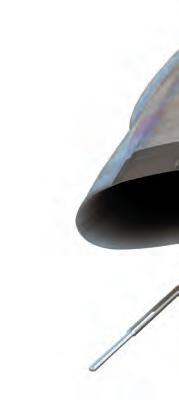














1953-1979 006
SERIES
CENTURY
FIGHTERS
Even as the F-86 Sabre was entering service with the USAF, North American designers Raymond Rice and Edgar Schmued were already considering developments that would signi cantly improve its performance. Initially, their attention was focused on the F-86’s wings and tailplane – increasing the sweepback from 35ᵒ to 45ᵒ and relocating the tailplane lower down. The company was con dent enough in this ‘Sabre 45’ project, begun in February 1949, to fund the modi cation of an XF-86D with these features.
An ‘Advanced F-86D’ proposal was eventually submitted to the USAF in August 1950, two months after the






































beginning of the Korean War. Although the Air Force was not able to take it forward at that time, North American was given a strong indication that the proposal would eventually be accepted. Work therefore continued on an ‘Advanced F-86E’, with the design receiving the internal designation NA-180. After two years of development, the NA-180 had little in common with the original F-86. It was larger and heavier with a host of novel features and was propelled by a much more powerful engine than its predecessor. North American had intended to equip the NA-180 with radar to make it a useful interceptor capable of replacing the F-86D but the USAF
F-100A-5-NA SUPER SABRE (54-5775)
ADRC Air Development and Research Center, 1954. This aircraft was among the rst Super Sabres produced – a ‘short-tail’ A model. This aircraft would later become part of the New Mexico ANG and was damaged beyond repair after suffering a hard landing on October 9, 1962. The pilot, 2/Lt David R McCauley, suffered severe burns but survived the crash.
F-100C-5-NA SUPER SABRE (53-1774)






322nd Fighter Day Group, 451sf Fighter Day Squadron, 1956. Notice the placement of the stars-and-bars insignia on this aircraft. National insignia would be carried on the nose early on in the F-100’s career, but from 1957 onward it was moved to the rear fuselage. This aircraft was sent to MASDC on January 17, 1972, but would later become part of the Turkish AF.
simply wanted was a straightforward high-performance day ghter armed with a quartet of 20mm cannon.

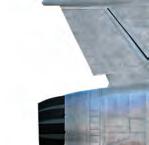



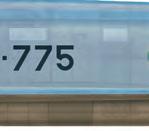

Following a full-scale mock-up inspection on November 9, 1951, requests were made for more than 100 separate changes to the design. The cockpit canopy was extended, the tailplanes were moved lower down and the shape of the fuselage was altered. Nevertheless, and despite concerns that the type would be too complicated, the USAF commissioned two prototypes and 110 full production ghter aircraft based on what was now the NA-192 design. The of cial designation ‘F-100’ was allocated the following month.

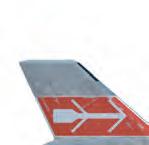




F-100C-25-NA SUPER SABRE (54-2101)

479th Fighter Day Group, 434th Fighter Day Squadron ‘Red Devils’, 1957. This aircraft is adorned with multi-coloured fuselage bands indicating that this aircraft was assigned to the wing commander.

CENTURY SERIES FIGHTERS 007
Work on the rst YF-100A commenced at the company’s facility in Inglewood, Los Angeles, in early 1952 and further changes to the design were made on the run. The nose was made 9in longer, the tailplanes and n were reduced in length but given greater chord and, in order to save weight, self-sealing fuel tanks were replaced with non-self-sealing tanks.
The USAF requested drop tank capability for increased range in October 1952 – necessitating the design of a new stronger wing – and developing






North American F-100 Super Sabre


this resulted in further delays. The initial YF-100A prototype, serial 52-5754, was completed on April 24, 1953. It was powered by a single Pratt & Whitney XJ57-P-7 non-afterburning turbojet (the series production model would have an afterburner) providing 8500lb-ft of thrust. The aircraft was then transported to Edwards Air Force Base in preparation for ight testing. Its rst ight, with Second World War ace turned North American test pilot George S ‘Wheaties’ Welch at the
F-100C-20-NA SUPER SABRE (54-1878)
36th Tactical Fighter Wing, 32nd Tactical Fighter Squadron (USAFE) ‘Wolfhounds’, late 1958. The squadron was operating out of Soesterberg AB in Holland. 54-1878 would be sent to the Military Aircraft Storage and Disposition Center (MASDC) on March 14, 1974, but later become a part of the Turkish AF. The aircraft would remain in service until well into the 80s.



controls, took place on May 25, 1953. Despite the lack of an afterburner, Welch managed to break the sound barrier in level ight at 30,000ft during the 55-minute ight. He did it again during a second ight 20 minutes later on the same day. The aircraft could go supersonic with ease above 30,000ft and could even approach the sound barrier at low level.
The same aircraft hit Mach 1.44 on July 6, 1953, during a dive from 51,000ft, and shortly thereafter the USAF






F-100D-65-NA SUPER SABRE (56-3000)
20th Tactical Fighter Wing, 1958. The CO aircraft of the 20th Tactical Fighter Wing is among the most well-known F-100s ever to y. The aircraft, known as ‘Triple Zilch’, is sporting the trim colours of the squadrons that comprised the wing: the 55th, 77th and 79th Tactical Fighter Squadrons, as well as the squadron patches. The aircraft sported this paint scheme in the late 50s while the wing was operating out of RAF Wethers eld and RAF Woodbridge. 56-3000 is today on display at the home base of the Texas ANG: Lackland AFB. However, it wears the colours of the Texas ANG rather than those of Triple Zilch.
008 CENTURY SERIES FIGHTERS
requested ghter-bomber capability for the F-100, prompting North American to add bomb rack attachment points to the new drop-tank capable wing design it was already working on.





The second prototype, serial 52-5755, ew for the rst time on October 14, 1953, with Welch again at the controls. Five days later an event was arranged to showcase the aircraft for the press. Welch stunned the assembled journalists by making a high-speed pass just feet from the ground which reportedly shattered the windows of the Palmdale airport administration building.
A week later the rst production model F-100A, serial 52-5756, made its
ight debut. Another Second World War veteran, Colonel Frank Kendall ‘Pete’ Everest, set a new world air speed record of 755.149mph in the aircraft that same day – breaking the previous record of 752.9mph set 26 days earlier by the US Navy’s James B Verdin ying a Douglas F4D Skyray.
North American triumphantly declared that it had constructed the world’s rst operational supersonic ghter, but the design still had numerous aws which needed to be addressed. Poor visibility over the nose made take-offs and landings dif cult, it was a handful at low speeds, longitudinal stability was lacking at high speeds and climb rate











was far less than desired. Rudder utter was also a problem early on but this was corrected with the aid of hydraulic dampers.
The rst operational unit to receive the F-100A was the 479th Fighter Day Wing of Tactical Air Command, based at George Air Force Base. Deliveries commenced in late November 1953 and North American made further changes to the design even as aircraft were rolling off the production line. The 104th F-100A received cockpit modi cations and from the 168th example the F-100A was powered by the Pratt & Whitney J57-P-39 with 16,000lb-ft of thrust. The last of 203 examples was constructed in April 1955.
CENTURY SERIES FIGHTERS 009
North American F-100 Super Sabre






F-100F-1-NA SUPER SABRE (56-3730)









20th Tactical Fighter Wing, 55th Tactical Fighter Squadron ‘Fighting Fifty Fifth’, 1960. This aircraft served with a multitude of units before it was sent to MASDC on September 14, 1977. Since 2006 it has been on display at the USAF Academy, Colorado Springs, Colorado.


F-100D-90-NA SUPER SABRE (56-3262)
48th Tactical Fighter Squadron, 492nd Tactical Fighter Squadron ‘Bolars’, 1959. Prior to the Vietnam war, the USAF was not shy about adding a bit of colour to its aircraft. The 48th TFW applied some particular ashy paint schemes to its aircraft when participating in a weapons meet at Nellis AFB in 1959. The 492nd, 493rd and 494th FTS all had at least one aircraft painted like this in the squadron’s respective trim colours (blue, yellow and red) and the CO aircraft that sported all three colours. Even for this era it was a very colourful aircraft.

F-100D-90-NA SUPER SABRE (56-3264)



405th Tactical Fighter Wing, 510th Tactical Fighter Squadron ‘Buzzards’, 1961. 56-3264 was part of a detachment deployed at Thailand’s Don Muang Airport in the spring of 1961. The aircraft would remain in SEA throughout the 60s with the 405th. On August 22, 1967, the aircraft was hit by AAA re. The pilot managed to y the crippled F-100 out over the South China Sea and eject, before being rescued by a US Army helicopter.







010 CENTURY SERIES FIGHTERS




























CENTURY SERIES FIGHTERS 011
CENTURY SERIES FIGHTERS





North American F-100 Super Sabre

F-100D-20-NA (55-3520)
USAF Demonstration team Thunderbirds, 1967. The F-100 was unique in serving with the Thunderbirds, being retired, and then being reinstated to the Thunderbirds inventory once again. In 1956 the Thunderbirds received F-100Cs which they operated until 1964, when they were replaced with the F-105B Thunderchief. The huge aircraft proved unsuitable for the role and the Thunderbirds decided to revert to the F-100 in July 1964, only this time they received F-100Ds. 55-3520 ew as the solo aircraft. The aircraft crashed on October 21, 1967 at Laughlin AFB, TX, after the engine exploded during a high g pull-up. The pilot did manage to bail out and survived the incident.
These early F-100s were generally disliked by their pilots – with the dif culty of ying the aircraft at low speeds resulting in a high accident rate. At around this time, six F-100As had their cannon replaced with a set of ve cameras beneath the cockpit to become RF-100As and were usually operated with four drop tanks instead of the usual F-100A load of two.
Back in December 1953, the USAF had decided that the last 70 F-100As off the production line should be modi ed as ghter-bombers with the new droptank and bomb-carrying wing – this was North American’s NA-214 design, later to be redesignated F-100Cs. Consequently,



on February 24, 1954, an order was placed for 230 F-100Cs, increasing to 564 by May 27.
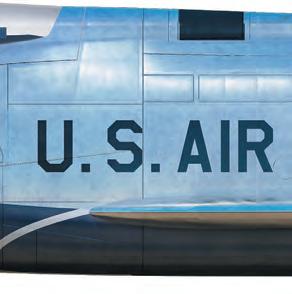



North American converted the fourth F-100A off the line into the YF100C prototype and each wingtip was extended 12in (this 2ft wingspan increase later being added to the regular F-100A production line). The wings themselves were adapted to carry drop tanks or up to 5000lb of external stores. The F-100C also had a removable in- ight refuelling probe installed under its starboard wing. The earliest examples of this were straight but the design was later changed to incorporate an upwards curve, which made it easier for the pilot to see it when
they were attempting to mate the probe with the drogue.







On September 27, 1954, the USAF ordered that many of the pre-ordered F-100Cs should be built as F-100Ds instead, while two days later the 479th nally became operational with the F-100A. The F-100D was to feature another new wing design – now with greater chord at the wingroot, increasing overall wing area and thereby decreasing landing speed. Explosive bolts allowed the underwing pylons to be jettisoned and a centreline hardpoint was added, along with electronic countermeasures, an AN/APS-54 tail warning radar and an AN/AJB-1 low-altitude bombing system.


012 CENTURY SERIES FIGHTERS










 Author: Scott Lowther £8.99
Author: Scott Lowther £8.99





























































































































































































































































































